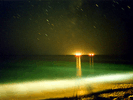Redshift, 2001
Named after an astrophysics light measurement in order to indirectly calculate the distance between objects (and consequently determine its age), Emily Richardson’s Redshift presents a vast, desolate nighttime landscape in which motion is realized through movements of light through empty spaces (achieved through fixed camera time-lapse photography) that is set to ambient white noise synthesized through the manipulated audio recording of the aurora borealis phenomenon near the magnetic north pole. Alternately familiar and strangely alien, Richardson creates a brief and serene meditation on celestial eternity and universal sense of place.
Behind This Soft Eclipse, 2004
Composed of recurring sequences of image negatives and filmed phenomena through aqueous mixed media that create a sense of visual otherworldliness, Eve Heller creates a surreal and evocative, albeit repetitive composition on instinctual object memory and connectedness.
Deliquium, 2003
Julie Murray’s Deliquium is a highly textural and visually multilayered stream of consciousness collage piece based on a poem about Lír, “the king who paid improper attention to his children.” Admittedly, I’m not familiar with this poem (the authorship on the program notes is unspecified, perhaps the filmmaker herself), and while elements of the poem are cryptically visible throughout the film, the execution of the piece – much like the poem itself – is highly abstract and baffling without contextual familiarity.
Luke, 1967/2004
Bruce Conner converts a 2 1/2 minute, 8mm “behind-the-scenes” film footage from the set of Cool Hand Luke (as the crew set up for a shot of convicts working alongside of the road) into a 22 minute still by still presentation (three images per second) that has been set to the soundtrack of a grandiose (albeit monotonously repetitive and distractingly prominent), swelling orchestra music. Although an interesting study in the dual quality of celluloid film both as both a still-life and a record of dynamic motion as well as the transformation of the mundane into “art” by the engaged process of visual pause, the manipulated footage is neither aesthetically well composed nor particularly interesting which made for a rather tedious experience.
Tabula Rasa, 1993-2004
Composed of a series of clinical shots of school hallways, empty stairwells, and classrooms set against the voices of students speaking in ungrammatical, often incoherent English as they describe the characteristics of their envisioned comic book heroes, Vincent Grenier’s Tabula Rasa is a thematically admirable, but artless and ultimately forgettable piece on the dehumanizing nature of institutions.
#6 Okkyung, 2004
Andrew Lampert’s sublime and fascinating entry for the continuing series of artist profiles on several New York City based improvising musicians is a silent, highly stylized, and stark black-and-white montage of cellist named Okkyung that conveys the artist’s focus and intensity of sound expression purely through assured gestures and passionate articulation.
Mirror, 2003
Presented as a highly formalized series of three separate character tableaus whose interrelation with – or disjunction from – each other is intrinsically (and systematically) transformed at each instance of flashing light solely through variations in setting (not in the position or pose of the characters), Christophe Girardet and Matthias Müller’s Mirror is an ingeniously conceived and elegantly crafted experiment on the subtle effects of modulation of mise-en-scène as well as a fascinating corollary to Kuleshov-like visual association of images and significance.
Michelangelo Eye to Eye, 2004
By the time Michelangelo Antonioni released Beyond the Clouds in 1995, his keen sense of patient, intimate observation had seemed to give way to a kind of leering, gratuitous voyeurism in the film’s repeated, over-lingering shots of the female form. It is, however, precisely this painstaking attention to the voluptuousness of form and tactileness of surfaces that makes his subsequent short film, Michelangelo Eye to Eye particularly sensual and textural in its execution. Prefaced with a text description of the filmmaker’s recent health problems (in particular, a debilitating stroke that left him partially paralyzed), the film opens with a shot of a frail Antonioni emerging from the shadows as he walks in slow, awkward gait into an unpopulated hall where Michelangelo Buonarotti’s marble statue of Moses – a scaled down version of an ambitiously conceived wall tomb for Pope Julius II – is once again in display after a period of meticulous restoration. Composed of a series of detailed observations of the sculpture’s composition from several camera angles and vantage points, Antonioni continually refocuses to the shot of Moses’ opaque gaze – an image that is sublimely matched by the filmmaker’s own occluded, returned gaze as he examines the object of his attention through limpid, watery eyes. In addition to creating a thorough, meticulous, and deliberative objective study of the Renaissance sculpture’s robust physical form and timeless, universal beauty, Antonioni’s juxtaposition of his own weakened, aging frame against the larger-than-life sculpture of Moses creates an indelible, thoughtful, and poignant image on human frailty, transience, creative compromise, and the enduring legacy of – and mortal transcendence through – enlightened art.
© Acquarello 2004. All rights reserved.
